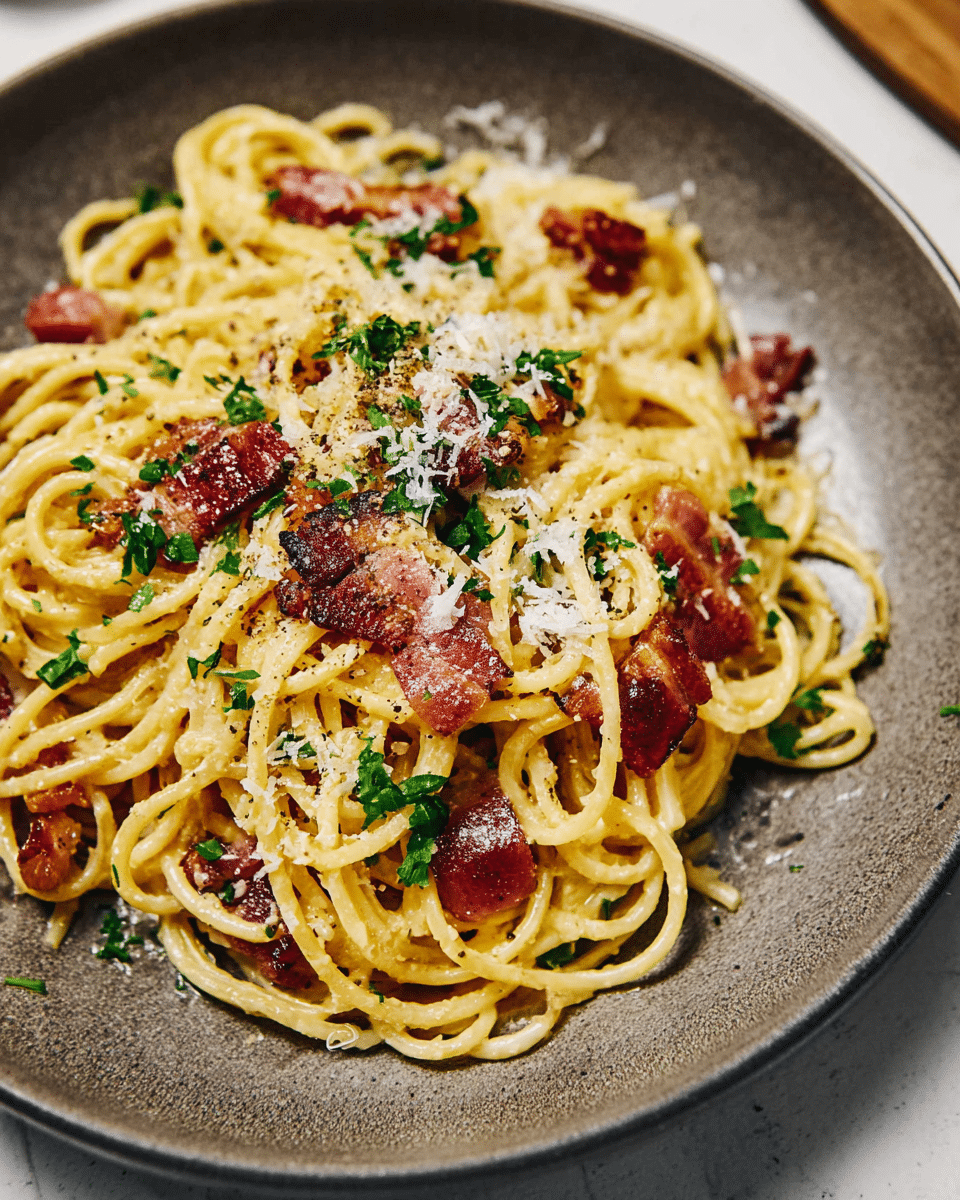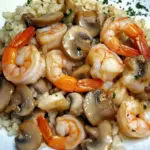The iconic Spaghetti Carbonara is a creamy, cheesy dream born in the heart of Roman cuisine. Made without cream and using just a handful of ingredients—eggs, cheese, pancetta, and pepper—this dish proves that simple really is better.
Each silky strand of spaghetti is coated in a rich, velvety sauce created by the emulsification of egg, cheese, and starchy pasta water. Crisp pancetta adds a salty crunch that contrasts beautifully with the tender pasta. It’s the perfect quick comfort food for weeknight dinners or a special Italian-inspired feast.
Full Recipe:
-
12 oz spaghetti
-
4 oz pancetta or guanciale, diced
-
2 large eggs
-
1 large egg yolk
-
3/4 cup grated Pecorino Romano cheese
-
Freshly ground black pepper, to taste
-
Kosher salt, to taste
-
1 tbsp olive oil (optional)
-
Reserved pasta water, as needed
Directions:
-
Bring a large pot of salted water to a boil. Add spaghetti and cook until al dente according to package instructions. Reserve 1 cup of pasta water before draining.
-
While pasta is cooking, heat a skillet over medium heat. Add pancetta and cook until crispy and golden brown, about 5-7 minutes. Remove from heat.
-
In a mixing bowl, whisk together eggs, egg yolk, grated Pecorino Romano, and a generous amount of freshly cracked black pepper. Set aside.
-
Immediately after draining the pasta, return it to the pot (heat turned off).
-
Quickly pour the egg mixture over the hot pasta, tossing rapidly to coat the noodles. Use some reserved pasta water, one tablespoon at a time, to loosen the sauce and create a creamy texture.
-
Fold in the crisped pancetta and any rendered fat from the skillet. Adjust seasoning with salt and pepper.
-
Serve immediately, topped with more Pecorino Romano and black pepper.
Prep Time: 10 minutes | Cooking Time: 15 minutes | Total Time: 25 minutes
Kcal: 480 kcal per serving | Servings: 4
The Origins of Spaghetti Carbonara
Spaghetti Carbonara, a quintessential Roman pasta dish, has a history as rich as its flavor. Though its exact origin is still a matter of culinary debate, many food historians trace its roots to mid-20th century Rome. One popular theory suggests that it was created during World War II when American soldiers stationed in Italy brought with them bacon and powdered eggs. Italian cooks adapted these ingredients with local pasta and cheese to create what we now recognize as Carbonara.
Others argue that Carbonara was simply an evolution of traditional Italian recipes, drawing influence from dishes like “cacio e ova,” a pastoral dish from central Italy made with cheese and eggs. The name “Carbonara” itself possibly comes from the Italian word carbonaro, meaning “charcoal burner,” suggesting it may have been a popular dish among Roman coal workers. Regardless of the specifics, Carbonara has become a beloved staple across the world and a true celebration of simplicity and culinary ingenuity.
What Makes Carbonara Unique
Unlike many other creamy pasta dishes, authentic Carbonara contains no cream whatsoever. Its silky texture comes from the emulsion of eggs, cheese, and starchy pasta water—a classic example of Italian cooking philosophy where less is more. The result is a velvety sauce that clings lovingly to the spaghetti without ever feeling heavy or overwhelming.
Another distinguishing feature is the use of guanciale, a cured pork cheek prized in Roman cuisine for its rich, fatty flavor. While pancetta (Italian cured pork belly) or even American bacon are commonly used substitutes, guanciale is considered the traditional and most flavorful choice.
The dish also relies heavily on Pecorino Romano, a salty, tangy sheep’s milk cheese that contributes sharpness and depth to the sauce. Freshly ground black pepper rounds out the flavor profile, adding warmth and contrast to the richness of the dish.
Carbonara: A Masterpiece in Technique
One of the most fascinating aspects of Carbonara is its delicate technique. Although the ingredient list is minimal, timing and temperature control are essential to avoid turning the eggs into scrambled bits. The goal is to create a creamy, cohesive sauce using the residual heat from the pasta and pan. For this reason, Carbonara is often seen as a test of a cook’s technical skill, even though it uses just a few humble components.
Another important part of mastering Carbonara is the pasta water. This starchy liquid acts as a natural thickener and is the secret behind achieving that smooth, glossy finish. Adding it slowly while tossing the pasta and sauce allows for perfect emulsification and helps balance the texture without thinning the flavor.
A Celebration of Simplicity and Quality
Carbonara exemplifies the Italian culinary tradition of honoring simplicity. It doesn’t rely on elaborate sauces or exotic spices—instead, it celebrates the quality of ingredients and the balance of fat, salt, and umami. This is why choosing the right components—whether it’s high-quality eggs, sharp Pecorino Romano, or authentic guanciale—can make all the difference in the final dish.
It also speaks to the Italian value of resourcefulness in cooking. The ingredients are pantry staples, yet when combined thoughtfully, they produce something greater than the sum of their parts. It’s a testament to how Italian cooking respects both food and tradition.
Common Mistakes to Avoid
One of the biggest pitfalls when making Carbonara is the addition of cream. Though it’s commonly added outside of Italy to enhance richness or make the recipe “foolproof,” purists argue that it dilutes the authentic flavor and texture.
Overheating the egg mixture is another common error. When eggs are added directly to hot pasta without proper temperature control or quick tossing, they can curdle, leading to a lumpy or overly thick sauce instead of the desired silky consistency.
Using pre-shredded cheese can also diminish the quality of the dish. These often contain anti-caking agents that prevent melting and emulsification. Grating fresh Pecorino Romano ensures better texture and richer flavor.
Why Spaghetti is the Ideal Pasta
Although Carbonara can be made with various types of pasta like rigatoni or fettuccine, spaghetti remains the gold standard. Its long, thin strands provide a perfect canvas for the sauce, allowing it to coat each bite evenly. The shape also enhances the visual appeal of the dish, with the creamy sauce delicately wrapped around golden noodles, speckled with bits of crispy pancetta and freshly ground pepper.
Moreover, spaghetti is quick to cook and widely accessible, making Carbonara both a practical and elegant dish that can be whipped up on any weeknight or served at a special dinner.
Modern Variations on Carbonara
In recent years, creative cooks and chefs have developed countless twists on the classic Carbonara. Vegetarian versions substitute mushrooms or smoked tofu for pancetta. Some add peas or asparagus for a touch of color and freshness. Others incorporate truffle oil or infuse the sauce with garlic to elevate the aroma.
While purists may shy away from such modifications, they highlight the versatility of Carbonara as a base dish. It’s a great starting point for experimentation, particularly for home cooks who want to adapt it to their dietary needs or personal preferences.
Cultural Significance and Popularity
Carbonara holds a special place not only in Italian cuisine but also in the hearts of food lovers worldwide. It’s comfort food at its finest—rich, satisfying, and indulgent, yet not overly complicated or inaccessible. Its international popularity has made it a mainstay on menus from Rome to New York and beyond.
In Italy, Carbonara Day (April 6) celebrates this iconic dish, where chefs and home cooks alike share their versions and discuss what makes it truly authentic. This ongoing conversation underscores how food can be a gateway to cultural dialogue and appreciation.
Pairings and Serving Suggestions
Because of its rich and salty nature, Carbonara pairs wonderfully with a crisp white wine such as Pinot Grigio or a light Italian red like Chianti. These wines cut through the richness of the sauce while enhancing the umami from the cheese and pancetta.
On the side, a simple green salad dressed with lemon vinaigrette balances the meal with freshness and acidity. Bread isn’t typically needed since the pasta is already hearty, but a slice of rustic Italian loaf can help soak up any remaining sauce on the plate.
For dessert, a light option such as panna cotta or fresh berries with mascarpone can complete the meal without overwhelming the palate.
Conclusion: Why Spaghetti Carbonara is a Timeless Classic
Spaghetti Carbonara stands as a timeless icon of Italian culinary mastery. With just five or six ingredients and a simple technique, it delivers a luxurious dish full of warmth, richness, and satisfaction. It’s a testament to the idea that great food doesn’t require complexity, just care, quality ingredients, and a love of tradition.
Whether you’re a home cook making it for the first time or a seasoned chef looking to perfect your emulsion technique, Carbonara invites you to slow down and savor the magic of Italian cooking. It’s a dish that connects people—through history, culture, and of course, the dinner table.






